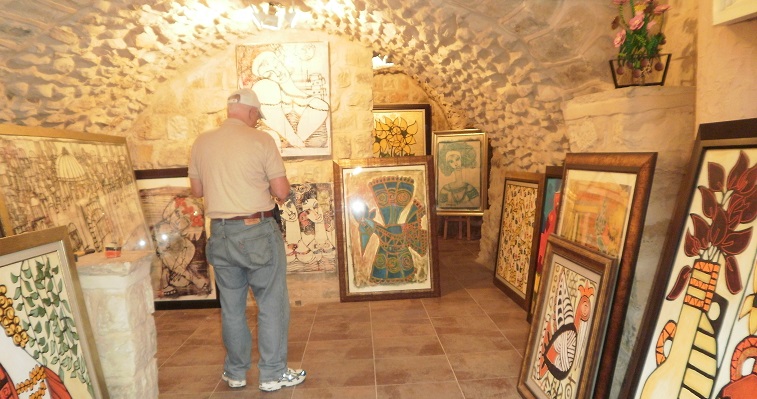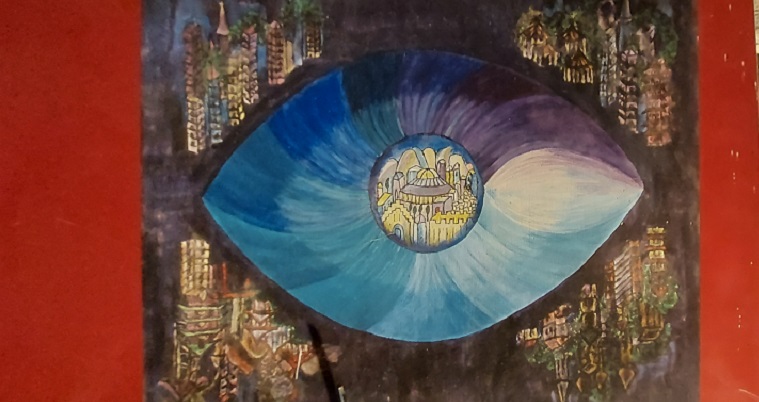The Aesthetic experience example
A significant field of study that aids in comprehending the interaction between an individual and a Sacred site is Art criticism and the Aesthetic experience, focusing on how a person perceives a work of Art and its impact on them.
The collection of essays on the Aesthetic experience, edited by American philosopher Michael H. Mitias[1], features compelling contributions from several prominent researchers. These works explore experiences that parallel what I perceive as inner religious experiences. The term “Aesthetic experience” was first coined by German philosopher Arthur Schopenhauer (1788-1860) in the early nineteenth century. He concluded that it involves an intense focus on the object before the observer, merging with the object, and setting aside practical concerns. This state of Aesthetic human experience entails a mental surrender to the object. Schopenhauer referred to this state as Aesthetic pleasure and, as noted, he originated the term “Aesthetic approach.”[2].
Mitias and his colleagues delve into the nuances of Aesthetic experiences and their meaning, one can use their insights as a metaphor to elucidate the nature of experiences of the Sacred in charismatic Sacred places. Mitias argues that in what might be termed real or charismatic artworks, there exists a potential for certain traits and characteristics to emerge through the observation and engagement of an external viewer. This forms a kind of phenomenology of Aesthetic qualities and features within a charismatic piece of art[3]. These qualities manifest in those receptive and fluent in its language, evoking specific emotions or responses. Consequently, a melancholic piece of music will invariably stir feelings of sadness in the listener, a reaction consistent across different individuals.[4]
According to Mitias, the quality of sadness exists in the music, not inherently but as a potential, (unlike the visible quality of red in an apple). He describes the perception of the Aesthetic experience as “a constructive creative activity.” [5] Furthermore, it is important to note that the trait of sadness is not isolated but forms part of a broader creation. The experience produces other feelings such as tenderness, or longing, and it part of a larger creation process.

Mitias references Osborne in outlining three types of Aesthetic qualities. The first type encompasses theoretical qualities, which include straightforward attributes like elegance, gracefulness, and beauty; formal qualities such as regularity, balance, and rhythm; and aspect qualities, described by adjectives such as dignified, solemn, and magnificent. The second type comprises arousing or affective qualities, characterized by adjectives like motivating, charming, or beautiful. The third type involves expressive qualities, which include adjectives such as sad, happy, or peaceful[6]. Mitias asserts that while these qualities are not presented as pre-arranged realities, they are recognized phenomenologically—we come to know and perceive them through the feeling of the heart[7].
In these Aesthetic qualities, connections to the Sacredness Generators can be discerned. For instance, regularity, balance, and rhythm correlate with fractal complexity; the festive and magnificent relate to the sublime extraordinary; combined feelings of sadness and joy correspond to the unifying duality. Furthermore, the Sacredness Generator of the connecting center ties to the act of observing and concentrating on a work of art, which facilitates the revelation of qualities not immediately visible. Thus, the emergence of the Aesthetic experience, prompted by a focused engagement with an artwork where Aesthetic qualities have been embedded, mirrors the emergence of the religious experience following a focus on the Sacred site center during a visit to a Holy place, whether introduced consciously or unconsciously.
Mitias argues that Art should not be judged merely by its sensory appearance, but by the responses it stimulates in the imagination of the observer. The essence of a work of Art lies not in its physical form but in its spiritual content, which gains form and meaning through the process of Aesthetic perception[8]. He notes that most works of Art are complex structures, with Aesthetic qualities layered in a hierarchical order[9]. This concept aligns with the perception of a Holy place as a site of fractal complexity.
The Aesthetic feature can manifest as meaning during the Aesthetic experience, inherently possessing a dual nature: potentiality, as it is inherent to the work of art, and meaning, as it is realized through the Aesthetic experience[10]. Perception is essential for the recognition and internalization of any tangible object. Therefore, when an object possesses specific properties, an individual reconstructs the unity of these properties within their perception or experience. This reconstruction allows them to understand how to interact with the object, positioning the object itself alongside the manner of its perception.[11].
Mitias elucidates that a vivid perception of an object, particularly a work of art, arises when sensory perception is wholly focused on that object. This intense focus involves the engagement of the senses and the full dedication of mental and cognitive faculties to the complex array of colors, lines, sounds, and other elements present in the artwork. In this state, one does not merely think about the object but also feels, perceives, and constructs a perception of it. The resulting perception is specific, tangible, and personal, tied uniquely to the object being observed. This aligns closely with the Sacredness Generator of the Connecting Center. Furthermore, an object is recognized as a work of Art because it presents a purposeful form that can facilitate meaningful experiences—experiences in which individuals find joy, enlightenment, and inspiration. The fundamental characteristic of a good work of Art is its capacity to convey human meaning[12]. This connection underscores the general relationship between the Aesthetic experience and art, and the religious or Sacred experiences in human life.
According to Mitias, a work of Art has the potential to motivate, enlighten, delight, and enhance an individual’s sense of self-worth, offering an opportunity for a meaningful experience. Thus, reaching a human meaning and the transformation of the self towards fulfillment and value are fundamental to artistic creation and perception[13]. Further drawing on Osborne’s ideas, Mitias asserts that an Aesthetic experience is a peak experience, one characterized by a perception devoid of practical purpose[14]. During this experience, the work of Art undergoes a process of spiritualization; the artist crafts a form that is capable of leading an individual to experience meaning, a principle that holds across all forms of art. The significance of the form persists as long as it can facilitate a life-enriching and meaningful experience. The texture of such an experience transcends mere perception, sensation, or emotion—it is an imaginative reality where feeling, emotion, and perception converge to create a unique type of awareness, a noetic perception[15]. This form, embodying these characteristics, is present in various types of art, and different individuals can share the same experiences when engaging with the same works[16].
Here, Mitias’s insights align closely with the concepts I am exploring in my work. First, he acknowledges the existence of certain archetypal “forms” that are capable of evoking a noetic experience in those who encounter them. Second, he suggests that this experience is, to a large extent, “objective” and consistent across different cases, implying that it transcends individual cultural backgrounds and is not solely dependent on them
In an Aesthetic experience, a distinctive kind of pleasure emerges from a collection of qualities that might aptly be termed “beauty.” [17] Similarly, the experience of holiness, encountered at a charismatic Holy site, is a unique type of emotion that arises from a set of potential attributes. This phenomenology comes alive particularly within visitor who approaches the site with an open disposition and the appropriate background or understanding (the right language).
Osborne identifies two distinct states of perception in individuals. The first is the normal state, tied to practicality and active involvement. The second state emerges from a stance of near distance—seemingly disinterested, though it actually requires engagement—and is characterized by an impractical approach. This particular state of perception is widely recognized and agreed upon by many theorists of the Aesthetic experience, such as the Polish philosopher Bohdan Dziemidok[18]. Osborne argues that the Aesthetic stance is deliberately distanced from practical and manipulative interests, as well as from hopes and fears, desires and rejections, aligning it more with a scientific approach. This stance not only facilitates a focused awareness and perception of the Aesthetic object, but also allows for their expansion, enabling a deeper appreciation and understanding of the self[19].
In practical life, a person is primarily focused on the reality of appearances—or the effects that this reality is expected to produce within them—whereas in Aesthetic perception, the interest lies in the spectacle itself[20]. Practically, a person categorizes things and then loses interest in them. However, in Aesthetic observation, a person is fully concentrated on a specific aspect, ignoring everything else, with the aim of achieving greater awareness. This awareness is non-judgmental, complete, and more detailed. The habit of categorizing leads to a deficiency in Aesthetic awareness.
Therefore, a lack of Aesthetic observational capacity can result in a person viewing an image of a sunset with a title, yet only perceiving the sunset itself, and not the subtler themes of femininity or sorrow embedded within it (for example). This phenomenon also extends to visits to charismatic Holy places by individuals with a normative religious background, as discussed in a later chapter on visiting Holy places. These individuals may not experience the sense of holiness due to their tendency to categorize the experience, thus missing the deeper, internal impact.
According to Osborne, losing a part of self-awareness while immersing oneself in the object is a defining characteristic of Aesthetic activity, but this phenomenon can also manifest in other areas of engagement[21]. I posit that this type of focused attention facilitates the experience of the Sacred, particularly through concentration on the connecting center of a Sacred place.
Osborne further suggests that an Aesthetic experience of wild nature often blends with a pantheistic and semi-mystical sense of identification with the entirety of creation[22], similar to the experiences at charismatic Holy places. He argues that there are parallels between profound engagements with great works of Art and mystical experiences. In both scenarios, there is a complete assimilation into the object of observation, where the controlling awareness of the self diminishes. This profound immersion leads to states of thought that may be considered a spiritual connection with a greater reality[23].
Mitias discusses the “Aesthetic situation” as a convergence zone where the features of the artwork, its creation, and the viewer intersect. He posits that this situation is composed of two fundamental elements: the formal structure of the artwork and the subjective awareness of the viewer. The fusion of these components during an event forms the Aesthetic situation, where each element assumes a new identity, necessitating an Aesthetic observer to animate the Aesthetic properties of the work[24].
Prior to the Aesthetic experience, the viewer’s awareness exists in a transitional state, poised as a potential for discovering meaning. This potential becomes an active, engaged awareness only upon encountering an object, with its identity shaped by the object experienced. The inherent qualities of the object are then transformed into meaningful content within the viewer’s consciousness. In the Aesthetic state, the viewer and the object—the artwork—merge into a distinct individual reality defined by the properties of the object and the viewer’s depth, sensitivity, and creative capacity. This state represents the dynamic flow of the Aesthetic experience, where the interaction between observer and artwork brings the Aesthetic qualities to life[25].
Terry J. Diffey suggests that in the nineteenth century, the concept of Aesthetics emerged as a type of human sensory impression, a feeling enjoyed for its own sake[26]: The artist infuses his ideas into a sensory form, which becomes the foundation of the viewer’s Aesthetic experience, animating the Aesthetic qualities within the work. This artistic tool offers a way to connect with the artist’s intentions. What is brought to life in the Aesthetic experience is an object crafted with considerable thought. Nevertheless, in every work of art, there are elements that remain unresolved, and it sometimes manages to unconsciously connect to universal archetypes[27]. Similarly, in the design of charismatic Holy places, much thought is invested and a strong intention is present among the designers, which largely succeeds in unconsciously linking with the archetypes of holiness. Top of Form

Robert Ginsberg describes the “redemptive,” or one might say “religious,” aspect of the Aesthetic experience as something that can elevate a person from the mundane and routine to the significant, eternal, and Sacred. He recounts an episode where, while at a train station returning from work, tired and bored, he suddenly perceived artistic shapes in the cracks of the windows, transforming the entire place into a vibrant and lively scene before his eyes. According to him, he was subconsciously seeking the Aesthetic and directed his steps towards this experience[28], which contained a form of redemption that transformed the dreariness into joy[29].
Ginsberg argues that the Aesthetic experience is inherently linked to a process of discovery, unfolding for the individual who undergoes it. He views Aesthetic discovery as a liberation from constraints and an elevation of the spirit. This discovery shifts the individual from mere spectatorship to active participation; they become an integral part of the event, engaging in a form of participatory involvement that enables them to rediscover themselves and the world[30]. The Aesthetic experience can thus be seen as a model and a step towards the sudden reconciliation of the alienated self with the world, transforming into a joyful and vibrant entity. Upon realizing this potential, a person may embark on a cosmic adventure, traversing the heavens on a path to redemption[31].
Ginsberg observes that in everyday life, people often rush from one conversation to another, rarely experiencing true presence. In contrast, the Aesthetic experience, whether fleeting or prolonged, offers a moment of profound presence that reveals the beauty of forms. This Aesthetic pleasure merges with presence, creating an intense emotional experience that enriches and enhances the overall encounter. The discovery within this experience leads to a creative contribution to what is being Aesthetically appreciated. In this context, the viewer is not a passive observer merely accepting what is presented; rather, they are the contributors, actively bestowing an exalted state upon the objects through their subjective engagement[32].
Furthermore, the Aesthetic experience can be a metaphysical event, and even if it is not, it is a model and preparation for such an event. Thus the Aesthetic is a type of experience that guides existential meaning, and not just a pursuit of luxury reserved for those with time and money[33]. In his article, Ginsberg describes two situations in which he had the Aesthetic experience, one at the train station, where the experience took place unexpectedly, and the other where he came alert, focused and expectant, to a view of a mountain peak, and on the way he discovered the chimney of a destroyed building, which integrated with the vertical component of the mountain and created an experience of exaltation and unity. In this case he was alert and ready and his senses were alert, and yet the discovery of the chimney was a surprise that brought with it a different kind of experience than he had expected. What helped the experience was the (quick) movement towards the observation point, that is towards the object[34]. And this, on loan, explains the importance of the process and the course of the visit to a charismatic Holy place, as one that enables the awakening of
Furthermore, Ginsberg posits that the Aesthetic experience can transcend into a metaphysical event, or at the very least, serve as a model and preparation for such occurrences. Thus, the Aesthetic is not merely a pursuit of luxury reserved for those with leisure and resources; it is a type of experience that imparts existential meaning[35].
In his article, Ginsberg describes two instances of the Aesthetic experience. The first occurred unexpectedly at a train station, and the second during a prepared visit to a mountain peak, where he was alert and focused. On this occasion, it was only when he encountered the chimney of a destroyed building, which merged with the mountain’s vertical element, that he experienced a profound sense of exaltation and unity. Despite his readiness, the discovery of the chimney was an unforeseen element that unexpectedly altered his experience. The approach to the observation point, moving towards the object, played a crucial role in facilitating this experience[36]. This emphasizes the importance of the process and journey to a charismatic Holy place, as it enables the emergence of a unique type of experience.

Footnotes
[1] Michael H. Mitias, (ed.), Possibility of the Aesthetic Experience, Dordrecht: Martinus Nijhoff Publishers, 1986
[2] Bohdan Dziemidok, “Controversy about Aesthetic Attitude: Does Aesthetic Attitude Condition Aesthetic Experience?”, in Michael H. Mitias (ed.), Possibility of the Aesthetic Experience, Dordrecht: Martinus Nijhoff Publishers, 1986, p. 139
[3] Michael H. Mitias, “Mode of Existence of Aesthetic Qualities”, in idem (ed.), Possibility of the Aesthetic Experience, Dordrecht: Martinus Nijhoff Publishers, 1986, p. 161
[4] Ibid p. 162
[5] Ibid p. 166
[6] Harold Osborne, “Expressiveness: Where is the feeling found?”, British Journal of Aesthetics 23 (1983), p. 114
[7] Michael H. Mitias, “Mode of Existence of Aesthetic Qualities”, in idem (ed.), Possibility of the Aesthetic Experience, Dordrecht: Martinus Nijhoff Publishers, 1986, p. 60
[8] Ibid p. 52
[9] Ibid p. 53
[10] Ibid
[11] Ibid p. 54
[12] Ibid p. 56
[13] Ibid
[14] Osborne, “Expressiveness”, p. 114
[15] Mitias, “Mode of Existence of Aesthetic Qualities”, p. 57
[16] Ibid p. 58
[17] Harold Osborne, “What Makes an Aesthetic Experience?”, in: Michael H. Mitias (ed.), Possibility of the Aesthetic Experience, Dordrecht: Martinus Nijhoff Publishers, 1986, pp. 117-138;
In this context, it is important to note that the “pleasure” associated with the aesthetic experience plays a crucial role in shifting a person’s attention away from themselves and towards the object that provides this pleasure. This is in contrast to suffering, which tends to draw a person’s focus inward, having the opposite effect. Top of Form
[18] Bohdan Dziemidok, “Controversy about Aesthetic Attitude: Does Aesthetic Attitude Condition Aesthetic Experience?”, in Michael H. Mitias (ed.), Possibility of the Aesthetic Experience, Dordrecht: Martinus Nijhoff Publishers, 1986, pp. 139-158
[19] Harold Osborne, “What Makes an Aesthetic Experience?”, in: Michael H. Mitias (ed.), Possibility of the Aesthetic Experience, Dordrecht: Martinus Nijhoff Publishers, 1986, pp. 117-138
[20] Ibid p. 122
[21] Ibid P. 123
[22] Ibid
[23] Ibid p. 129
[24]Michael H. Mitias, “Mode of Existence of Aesthetic Qualities”, in idem (ed.), Possibility of the Aesthetic Experience, Dordrecht: Martinus Nijhoff Publishers, 1986, p. 164
[25] Ibid p. 165
[26] Terry J. Diffey, “The Idea of Aesthetic Experience”, in: Michael H. Mitias (ed.), Possibility of the Aesthetic Experience, Dordrecht: Martinus Nijhoff Publishers, 1986, p. 11
[27] Michael H. Mitias, “Mode of Existence of Aesthetic Qualities”, in idem (ed.), Possibility of the Aesthetic Experience, Dordrecht: Martinus Nijhoff Publishers, 1986, p. 165
[28] Robert Ginsberg, “Experiencing Aesthetically, Aesthetic Experience, and Experience in Aesthetics”, in: Michael H. Mitias (ed.), Possibility of the Aesthetic Experience, Dordrecht: Martinus Nijhoff Publishers, 1986, p. 61
[29] Ibid p. 33
[30] Ibid p. 34
[31] Ibid p. 35
[32] Ibid
[33] Ibid p. 71
[34] Ibid p. 67
[35] Ibid p. 71
[36] Ibid p. 67

Bibliography
Diffey, Terry J., “The Idea of Aesthetic Experience”, in: Michael H. Mitias (ed.), Possibility of the Aesthetic Experience, Dordrecht: Martinus Nijhoff Publishers, 1986, pp. 3-12.
Dziemidok, Bohdan, “Controversy about Aesthetic Attitude: Does Aesthetic Attitude Condition Aesthetic Experience?”, in Michael H. Mitias (ed.), Possibility of the Aesthetic Experience, Dordrecht: Martinus Nijhoff Publishers, 1986, pp. 139-158.
Ginsberg, Robert, “Experiencing Aesthetically, Aesthetic Experience, and Experience in Aesthetics”, in: Michael H. Mitias (ed.), Possibility of the Aesthetic Experience, Dordrecht: Martinus Nijhoff Publishers, 1986, pp. 61-78.
Kandinsky, Wassily, Concerning the Spiritual in Art, Bexar County, TX: Bibliotech Press, 2012.
Mitias, Michael H., “Can We Speak of ‛Aesthetic Experience’?”, in idem (ed.), Possibility of the Aesthetic Experience, Dordrecht: Martinus Nijhoff Publishers, 1986, pp. 47-58.
———-, “Mode of Existence of Aesthetic Qualities”, in idem (ed.), Possibility of the Aesthetic Experience, Dordrecht: Martinus Nijhoff Publishers, 1986, pp. 159-168.
Osborne, Harold, “What Makes an Aesthetic Experience?”, in: Michael H. Mitias (ed.), Possibility of the Aesthetic Experience, Dordrecht: Martinus Nijhoff Publishers, 1986, pp. 117-138.
———-, “Expressiveness: Where is the feeling found?”, British Journal of Aesthetics 23 (1983), pp. 112-123.
———-, “Inspiration”, British Journal of Aesthetics 17 (1977), pp. 242-253.
Panofsky, Dora, and Erwin Panofsky, Pandora’s Box: The Changing Aspects of a Mythical Symbol, New York: Pantheon Books, 1956.
Ulrich, Roger S., “Aesthetic and Affective Response to Natural Environment”, in Irwin Altman and Joachim F. Wohlwill (eds.), Behavior and the Natural Environment, New York: Plenum Press, 1983, pp. 85-125




